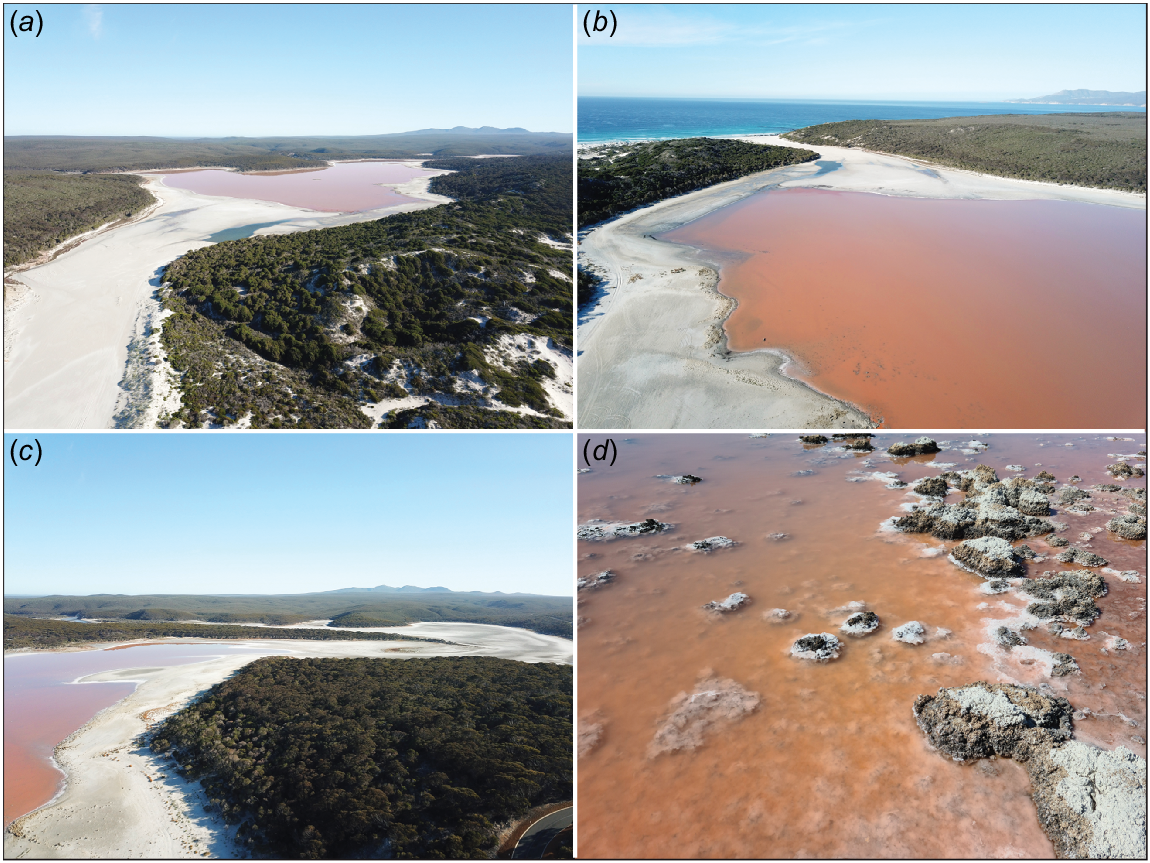Protracted bar closure temporarily transforms an estuary into a salt lake
James R. Tweedley A * and Kurt N. Krispyn A
A * and Kurt N. Krispyn A
A
Keywords: berm, climate change, ecosystem services, fish kill, hyperhaline, hypersalinity, low-inflow, normally-closed, temporarily open-closed estuary.
Estuaries are traditionally regarded as transitional systems located between, and exchanging water with, rivers and the ocean. As such, their salinity typically ranges from fresh to marine (0 to 35 ppt). There are, however, some estuaries that become hypersaline (salinity >40 ppt). These are most common in tropical, arid, and warm-temperate climates with low and/or highly seasonal rainfall and low tidal ranges, such as south-western Australia (Tweedley et al. 2019; Largier 2023). During times of limited discharge from the estuary, sand accumulates forming a bar that, when sufficiently large, disconnects the system from the ocean. If evaporation exceeds fluvial input salinity levels can increase and become hypersaline.
Hamersley Inlet (33°57′52.17″S, 119°54′25.41″E) is a 2.3 km2 estuary located in the Fitzgerald River National Park and UNESCO Biosphere on the south coast of Western Australia. The estuary is known to become hypersaline, with ad hoc salinity measurements recorded between 1999 and 2011 ranging from 23 to 308 ppt, of which 73% exceed 40 ppt (n = 263; https://wir.water.wa.gov.au/). In November 2020, the bar at the estuary mouth was several metres high and ~800 m wide preventing overtopping of marine waters (Fig. 1a and b). Water levels had receded to <35% of the estuary area, exposing large expanses of marginal shoal containing rocks, serpulid polychaete mounds (likely Ficopomatus enigmaticus) and fish carcases (mugilids and sparids), and encrusting them with salt crystals (Fig. 1c and d). Evapoconcentration led to the formation of a ~0.7 km2 hypersaline pool in the basin (mean salinity = 344.9 ppt ± 0.3 s.e.) and several smaller isolated pools in the Hamersley River (mean salinity = 265.9 ppt ± 1.7 s.e.). These salinities are the highest ever recorded for an estuary globally (Tweedley et al. 2019). Waters were shallow (typically <1 m), warm (~29°C) and hypoxic (~1.00 mg L−1). The vivid colour of the water was likely caused by various carotenoid-producing halophiles, such as the green algae Dunaliella and bacteria Salinibacter, which are common in nearby hypersaline lakes (Sierra et al. 2022).
Hamersley Inlet, Fitzgerald River National Park, Western Australia in November 2020, following several years of low rainfall. The (a) ~800 m wide sand bar that disconnected the estuary from the Southern Ocean and (b) hypersaline pool (mean salinity = 345 ppt) that formed in the basin area from the substantial drop in water level associated with evapoconcentration and contained carotenoid-producing halophiles. (c) Aerial view from the basin towards the lower reaches of the Hamersley River, which contained small, isolated pools (mean salinity = 266 ppt) and (d) the view from ground level showing salt crystallisation from supersaturation which encrusted exposed rocks and serpulid mounds.

Species richness decreases with increasing hypersalinity, reducing ecosystem complexity and simplifying trophic linkages (Tweedley et al. 2019). The extreme salinities in Hamersley Inlet were considerably greater than those in which the most salt-tolerant local fish species, the atherinid Atherinosoma elongatum, has been recorded (i.e. 147 ppt; Tweedley et al. 2019). Traditionally, estuaries provide numerous ecosystem services including nursery habitats for juvenile fish, some of which are targeted recreationally and commercially, and nutrient recycling. However, prolonged bar closure prevents the immigration of fish and associated hypersalinity can cause mass mortalities of fish and invertebrates (Tweedley et al. 2019). Under these conditions, ecosystem service provision is severely limited which can have broader impacts such as reduced food resources for migratory shorebirds.
South-western Australia is a climate change hotspot. Stream flow has declined markedly and is predicted to reduce further due to declines in winter rainfall. Combined with sedimentation and secondary salinisation from land clearing, the incidence of prolonged bar closure and hypersalinity is likely to increase, deleteriously impacting south-western Australian estuaries, their associated fauna and the provision of ecosystem services.
Data availability
The data that support this study will be shared upon reasonable request to the corresponding author.
Acknowledgements
Gratitude is expressed to Leigh Sheppard for accompanying the authors during the fieldwork and to Neil Loneragan and John Huisman for their useful discussions on aspects of the manuscript.
References
Largier JL (2023) Recognizing low-inflow estuaries as a common estuary paradigm. Estuaries and Coasts 46(8), 1949-1970.
| Crossref | Google Scholar |
Sierra MA, Ryon KA, Tierney BT, Foox J, Bhattacharya C, Afshin E, Butler D, Green SJ, Thomas WK, Ramsdell J, Bivens NJ, McGrath K, Mason CE, Tighe SW (2022) Microbiome and metagenomic analysis of Lake Hillier Australia reveals pigment-rich polyextremophiles and wide-ranging metabolic adaptations. Environmental Microbiome 17(1), 60.
| Crossref | Google Scholar |
Tweedley JR, Dittmann SR, Whitfield AK, Withers K, Hoeksema SD, Potter IC (2019) Hypersalinity: global distribution, causes, and present and future effects on the biota of estuaries and lagoons. In ‘Coasts and estuaries’. (Eds E Wolanski, JW Day, M Elliott, R Ramachandran) pp. 523–546. (Elsevier) doi:10.1016/B978-0-12-814003-1.00030-7


